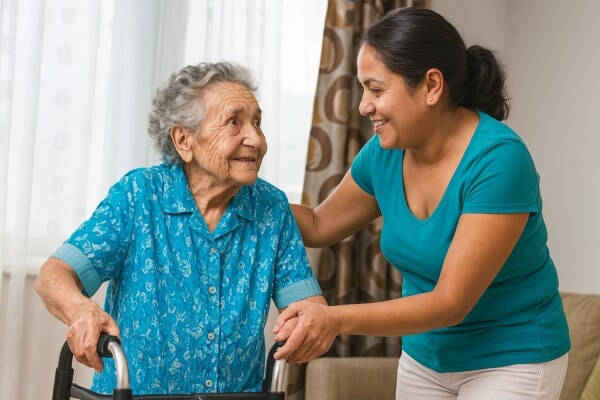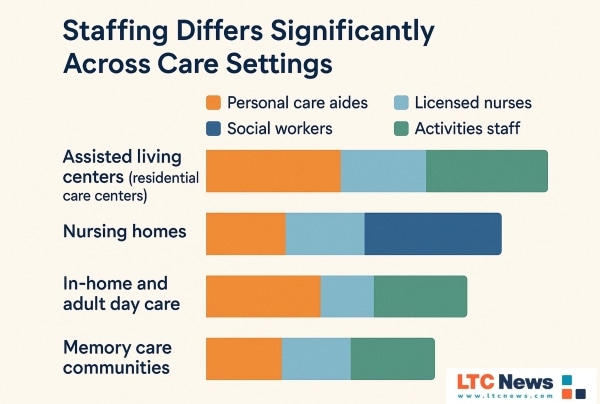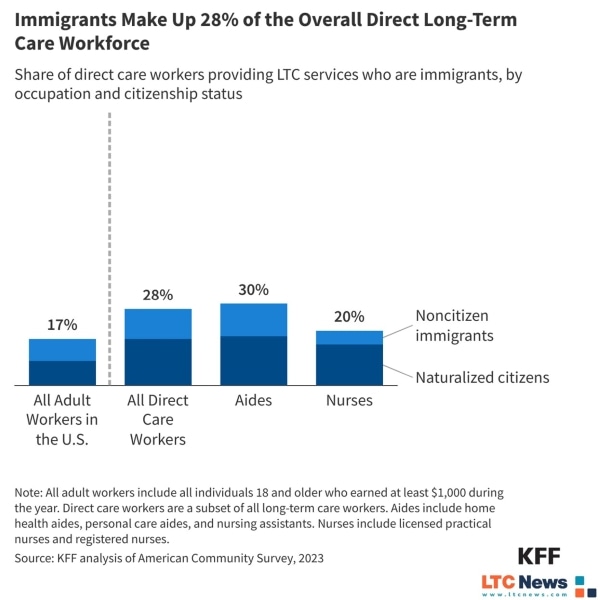Personal Care Aides Provide 76% of Residential Care Hours, New Data Show

With the growing number of people needing extended care services, you might find comfort in knowing that personal care aides—a group often unseen—are delivering the majority of care hours in residential care centers. Yet, the details matter if you're planning for a loved one’s care, now or in the future.
According to Open Minds, in 2022, personal care aides accounted for 76 percent of full-time equivalent staff providing direct care at residential care communities (RCCs) and 63.2 percent at adult day care centers.
Other research from the Kaiser Family Foundation (KFF) reinforces that—across settings—over three‑quarters (77 percent) of direct care workers are aides, including personal care aides, home health aides, and nursing assistants.
These aides perform essential tasks—bathing, dressing, feeding, mobility support—that keep residents safe and dignified. More medical roles, like RNs or LPNs, fill only a small portion of direct care hours in these settings.

What “Residential Care Centers” Really Mean
The CDC data that show 76% of care hours in residential care centers are delivered by personal care aides specifically refer to assisted living facilities—sometimes called personal care homes, depending on the state. These communities provide 24-hour housing, meals, and support with activities of daily living (ADLs), such as bathing, dressing, eating, and managing medications.
They differ from other long-term care options in important ways:
Assisted Living (Residential Care Centers)
- Who they serve: Older adults who can no longer live safely on their own but don’t need 24/7 medical care.
- Services provided: Meals, help with daily tasks, housekeeping, social activities, and medication support.
- Staffing: Primarily personal care aides (76 percent of direct care hours), with some licensed nurses and activity staff.
- Housing: Residents live there full-time in a less institutional setting.
RELATED: Guide to Assisted Living: Facility Services, Costs, and Search Tools
In-Home Caregivers
- Who they serve: Adults who want to remain in their own home (or the home of a family member) but need help with daily tasks, light supervision due to memory decline, or personal care.
- Services provided: Assistance with ADLs, light housekeeping, meal prep, and transportation.
- Staffing: Typically, personal care aides or home health aides provide the care. Nurses may visit if medical tasks are required.
- Housing: Person remains at home; caregivers visit part-time or full-time.
RELATED: Guide to Home Care: Services, Costs, and Search Tools
Adult Day Care Centers
- Who they serve: Adults who live at home but need daytime supervision, social activities, or help with meals and personal care.
- Services provided: Group activities, meals, limited health services, supervision, often respite care for family caregivers
- Staffing: Mix of personal care aides, activity coordinators, and sometimes nurses.
- Housing: Daytime only; participants return home in the evening, where family caregivers or professional caregivers take over.
RELATED: Adult Day Care Centers (ADCCs) - Part of Caregiving and Long-Term Health Care
Memory Care Communities
- Who they serve: Adults living with Alzheimer’s or other forms of dementia.
- Services provided: All assisted living services, plus specialized programs for memory support, safety features (secured doors), and higher staff-to-resident ratios.
- Staffing: Specially trained personal care aides, often with more intensive oversight from nurses and therapists.
- Housing: Full-time, secured environment, often a section of an assisted living facility.
RELATED: Comprehensive Guide to Memory Care
Nursing Homes (Skilled Nursing Facilities)
- Who they serve: Adults who need 24-hour medical care and supervision, often with complex health needs.
- Services provided: Skilled nursing, rehab services, medication management, and personal care.
- Staffing: Higher proportion of registered nurses (RNs), licensed practical nurses (LPNs), and certified nursing assistants (CNAs).
- Housing: Residents live there full-time in an institutional setting.
RELATED: Complete Guide to Nursing Homes
Who Are These Workers—and What Do They Face?
The direct care workforce is predominantly female (87 percent), low-wage (65 percent), with a significant share over age 50 (41 percent).
According to PHI, the training requirements vary: aides generally have minimal mandated training, unlike home health aides and nursing assistants, who often need at least 75 hours of training plus supervised practical hours. These gaps affect quality and workforce development.
Why This Matters for You—and Your Loved One
1. Quality of Care Depends on Workforce Strength
If 76 percent of care hours hinge on aides, high turnover or understaffing can directly impact safety and consistency. Staffing shortages can create issues with quality of extended care.
2. Policy and Funding Shape Care Availability
Medicaid, the primary payer of long-term care, historically underpays providers. Federal efforts, such as the American Rescue Plan and new Medicaid rules that direct more funds toward direct care worker pay, are underway, but challenges remain.
Private pay providers, including those care providers paid with Long-Term Care Insurance, are often more plentiful and sometimes better quality because of higher pay and less turnover, according to experts.
3. Your Choice: Several Care Options Available
In-home caregivers allow a loved one to remain at home. Adult day care centers offer structured activity, supervision, and companionship. Assisted living provides a non-institutional environment, and spouses can stay together even if one remains independent. Usually, LTC Insurance covers these services, while Medicare and health insurance do not.
Utilizing adult day care can reduce the need for full residential care, save on costs, and offer respite—especially during LTC Insurance elimination periods.
How President Trump’s Immigration Enforcement Is Undermining Care Staffing
Immigration policy might not be the first thing you connect to long-term care, but it has a direct impact on who shows up to care for your loved ones. Immigrants make up nearly 28 percent of the direct care workforce, including personal care aides in assisted living, home health aides, and nursing assistants in nursing homes, according to the Kaiser Family Foundation.

In home care specifically, about one in three workers is an immigrant. Under President Donald Trump, immigration enforcement has intensified. In early 2025, the administration ended a 2021 rule that limited immigration raids at health care facilities. That rollback, combined with stricter deportation actions and reduced visa pathways, is straining an already fragile workforce.
Facilities across the country report:
- Fear-driven absenteeism among immigrant workers, even those with legal status, is a concern because of raids.
- Loss of Temporary Protected Status (TPS) and other work authorizations is pushing long-time caregivers out of the labor force.
- Shrinking labor pipelines for home health and residential care, where demand is surging as the U.S. population ages.
Immigrant workers are essential to long-term care. When enforcement drives them away, it leaves families and facilities scrambling, and older adults suffer most. — Robert Espinoza, CEO of the National Skills Coalition, in a recent interview on NPR.
The result, according to experts, is higher turnover, fewer trained staff, and increased pressure on personal care aides—the very workers who already provide 76 percent of care hours in residential communities. Staffing shortages can create higher costs and lack of available care in some areas.
Finding Care: LTC News Caregiver Directory Helps You Search
You can search for adult day care centers and other long-term care services via the LTC News Caregiver Directory. It’s free and filters by:
- Service type (in‑home care, adult day care, assisted living)
- Location (search by city or zip code) and amenities
- Pricing (use alongside the LTC News Cost of Care Calculator to compare average costs with those of the providers you are considering.
Final Thoughts: Questions Worth Asking Yourself
- Does daily structure, supervision, and community matter for your loved one—without full-time residency?
- Do you have an LTC Insurance policy that covers adult day care centers and assisted living, in addition to in-home care, memory care, and nursing homes?
- Have you checked local listings through the LTC News Caregiver Directory?
- How might staffing trends—like reliance on aides—shape quality and availability of care?
If you're planning now, which most people do before they retire, you’re giving yourself—and your loved ones—a path toward better options, flexibility, and peace of mind.
You or a loved one may one day need long-term care because of a chronic illness, an accident, mobility challenges, dementia, or simply the frailty that comes with aging. Aging always wins—but preparing ahead can ease the burden on the people you love.


